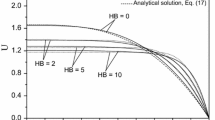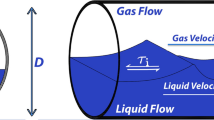Abstract
In this research, the developing turbulent swirling flow in the entrance region of a pipe is investigated analytically by using the boundary layer integral method. The governing equations are integrated through the boundary layer and obtained differential equations are solved with forth-order Adams predictor-corrector method. The general tangential velocity is applied at the inlet region to consider both free and forced vortex velocity profiles. The comparison between present model and available experimental data demonstrates the capability of the model in predicting boundary layer parameters (e.g. boundary layer growth, shear rate and swirl intensity decay rate). Analytical results showed that the free vortex velocity profile can better predict the boundary layer parameters in the entrance region than in the forced one. Also, effects of pressure gradient inside the boundary layer is investigated and showed that if pressure gradient is ignored inside the boundary layer, results deviate greatly from the experimental data.
Similar content being viewed by others
Abbreviations
- C :
-
Constant of tangential velocity definition
- C 0 :
-
Constant of tangential velocity definition at the pipe inlet
- D :
-
Pipe diameter, m
- E = (δ z /δ θ )1/7:
-
One-seventh power of the axial/tangential boundary layer thicknesses
- F :
-
Force that act on the boundary layer in axial direction, N
- \({\dot{m}}\) :
-
Mass flow rate, kg s−1
- p :
-
Static pressure, N m−2
- p δ :
-
Static pressure outside the boundary layer, N m−2
- \({\dot {P}}\) :
-
Momentum rate, m Kg s−2
- R :
-
Radius of pipe, m
- Re :
-
Reynolds Number based on pipe diameter
- r, θ, z:
-
Coordinates
- S :
-
Swirl intensity
- S 0 :
-
Swirl intensity at the pipe inlet
- U z0 :
-
Axial velocity at the pipe inlet, m s−1
- U z :
-
Axial velocity at the edge of boundary layer, m s−1
- U θ :
-
Tangential velocity at the edge of boundary layer, m s−1
- u z :
-
Axial velocity in the boundary layer, m s−1
- u θ :
-
Tangential velocity in the boundary layer, m s−1
- δ z :
-
Axial boundary layer thickness, m
- δ θ :
-
Tangential boundary layer thickness, m
- δ*:
-
Displacement thickness, m
- υ :
-
Kinematic viscosity, m2s−1
- ρ :
-
Density, Kg m−3
- θ*:
-
Momentum thickness, m
- τ z :
-
Axial wall shear stress, N m−2
- τ θ :
-
Tangential wall shear stress, N m−2
References
Algifri A.H., Bhardwaj R.K., Rao Y.V.N.: Eddy viscosity in decaying swirl flow in a pipe. Appl. Sci. Res. 45, 287–302 (1988)
Lucca-Negro O., O’Dohery T.: Vortex breakdown: a review. Prog. Energy Combust. Sci. 27, 431–481 (2001)
Alekseenko S.V., Kuibin P.A., Okulov V.L., Shtork S.I.: Helical vortices in swirl flow. J. Fluid Mech. 382, 195–243 (1999)
Concha F.: Flow pattern in Hydrocyclones. KONA 25, 97–132 (2007)
Taylor G.I.: The boundary layer in the converging nozzle of swirl atomizer. Quart. J. Mech. Appl. Math. 3, 129–139 (1950)
Talbot L.: Laminar swirling pipe flow. J. Appl. Mech. 21, 1–7 (1954)
Weber H.E.: The boundary layer inside a conical surface due to swirl. J. Appl. Mech. 23, 587–592 (1956)
Murray J.D.: The boundary layer on a flat plate in a stream with uniform shear. J. Fluid Mech. 11, 309–316 (1961)
Kreith F., Sonju K.: The decay of a turbulent swirl in a pipe. J. Fluid Mech. 22, 257–271 (1965)
Rochino, A., Lavan, Z.: Analytical Investigations of Incompressible Turbulent Swirling Flow in Stationary Ducts. ASME Transactions. J. Appl. Mech., pp. 151–158 (1969)
Najafi A.F., Saidi M.H., Sadeghipour M.S., Souhar M.: Boundary layer solution for the turbulent swirling decay flow through a fixed pipe: SBR at the inlet. Int. J. Eng. Sci. 43, 107–120 (2005)
Hsieh K.T., Rajamani R.K.: Mathematical model of the hydrocyclone based on physics of fluid flow. AIChE J. 37, 735–746 (1991)
Vyas, A.B., Majdalani, J.: The bidirectional vortex. Part 1: an exact inviscid solution. In: 39th AIAA/ASME/SAE/ASEE Joint Propulsion Conference and Exhibit, Huntsville, 5052 (2003)
Vyas, A.B., Majdalani, J.: The bidirectional vortex. Part 2: viscous core corrections. In: 39th AIAA/ASME/SAE/ASEE Joint Propulsion Conference and Exhibit, Huntsville, 5053 (2003)
Majdalani J., Rienstra S.W.: On the bidirectional vortex and other similarity solution in spherical coordinates. Z. Angew. Math. Phys. 58, 289–308 (2007)
Vyas A.B., Majdalani J.: Exact solution of the bidirectional vortex. AIAA J. 44, 2208–2216 (2006)
Yajnik K.S., Subbaiah M.V.: Experiments on swirling turbulent flows: part 1. Similarity in swirling flows. J. Fluid Mech. 60, 665–687 (1973)
Kitoh O.: Experimental study of turbulent swirling flow in a straight pipe. J. Fluid Mech. 225, 445–479 (1991)
Algifri A.H., Bhardwaj R.K., Rao Y.V.N.: Turbulence measurement in decaying swirl flow in a pipe. Appl. Sci. Res. 45, 233–250 (1988)
Chang F., Dhir V.K.: Mechanisms of heat transfer enhancement and slow decay of swirl in tubes using tangential injection. Int. J. Heat Fluid Flow 16, 78–87 (1995)
Kobayashi T., Yoda M.: Modified k−ε model for turbulent swirling flow in a straight pipe. JSME Int. J. 30, 66–71 (1987)
He, P., Salcudean, M., Gartshore, I.S.: A numerical simulation of hydrocyclones. Trans. IChemE 77, Part A 429–441 (1999)
Ma L., Ingham D.B., Wen X.: Numerical modeling of the fluid and particle penetration through small sampling cyclones. J. Aerosol Sci. 31, 1097–1119 (2000)
Yoshida H.: Three-dimensional simulation of air cyclone and particle separation by a revised-type cyclone. Colloids Surf. 109, 1–12 (1996)
Hansen, K.G., Madsen, J.: A computational and experimental study of the internal flow in a scaled pressure-swirl atomizer. M.Sc. Thesis, Aalborg Universitet Esbjerg (2001)
Evans W.K., Suksangpanomrung A., Nowakowski A.F.: The simulation of the flow within a hydrocyclone operating with an air core and with an inserted metal rod. Chem. Eng. J. 143, 51–61 (2008)
Narasimha M., Brennan M., Holtham P.N.: Large eddy simulation of hydrocyclone-prediction of air-core diameter and shape. Int. J. Miner. Process. 80, 1–14 (2006)
Schlichting H.: Boundary Layer Theory. McGraw-Hill, New York (1973)
Burden, R.L., Faires, J.D.: Numerical Analysis, 7th edn. Brooks/Cole, Belmont, ISBN: 0534 382169 (2000)
Author information
Authors and Affiliations
Corresponding author
Rights and permissions
About this article
Cite this article
Maddahian, R., Kebriaee, A., Farhanieh, B. et al. Analytical investigation of boundary layer growth and swirl intensity decay rate in a pipe. Arch Appl Mech 81, 489–501 (2011). https://doi.org/10.1007/s00419-010-0424-9
Received:
Accepted:
Published:
Issue Date:
DOI: https://doi.org/10.1007/s00419-010-0424-9




